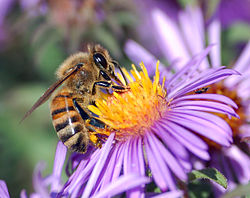పుప్పొడి
ఈ వ్యాసాన్ని ఏ మూలాల నుండి సేకరించిన సమాచారాన్ని ఆధారంగా చేసుకొని వ్రాసారో తెలపలేదు. సరయిన మూలాలను చేర్చి వ్యాసాన్ని మెరుగు పరచండి. ఈ విషయమై చర్చించేందుకు చర్చా పేజీని చూడండి. |

పుప్పొడి అనగా విత్తనపు మొక్కల యొక్క సూక్ష్మసంయుక్తబీజాలు (microgametophytes) కలిగిన మృదువైన ముతక పొడి, ఇది మగ బీజ కణాల్ని (వీర్యకణాలు) ఉత్పత్తి చేస్తుంది. పుప్పొడి కేసరాల నుండి పుష్పించే మొక్కల అండకోశానికి చేరుకునే సమయంలో లేదా కనీఫెరోయాస్ మొక్కల యొక్క మగ కోన్ నుండి ఆడ కోన్ కు చేరుకునే సమయంలో పుప్పొడి రేణువులు కలిగిన ఒక గట్టి పూత వలన ఆ వీర్యకణాలు రక్షింపబడతాయి. పుప్పొడి ఆడ కోన్ ను లేదా అనుకూల అండకోశాన్ని చేరుకున్నప్పుడు (అంటే పరాగ సంపర్కం జరుగుతున్నప్పుడు) ఇది మొలకెత్తుతుంది (germinates), ఒక పుప్పొడినాలం (pollen tube) ఉత్పత్తి అయ్యి అది అండాశయానికి (ovule) (లేదా ఆడ సంయుక్తబీజంకు) ఆ స్పెర్మ్ బదిలీ అవుతుంది. ఇండివిడ్యువల్ పుప్పొడి రేణువుల వివరాలు చూడటానికి తగిన మాగ్నిఫికేషన్ (పెద్దదిగా చూపించునది) అవసరం. పుప్పొడి యొక్క అధ్యయనాన్ని పాలినాలజీ (palynology) అంటారు, paleoecology, పురాజీవశాస్త్రం, పురాతత్వ శాస్త్రం, ఫోరెన్సిక్స్ అధ్యయనాలలో పుప్పొడి అధ్యయనం అత్యంత ఉపయోగకరంగా ఉంటుంది.
పరాగ సంపర్కము
[మార్చు]పుష్పించే మొక్కలలోని పరాగకోశంలోని పరాగ రేణువులు కీలాగ్రాన్ని చేరడాన్ని పరాగసంపర్కం (Pollination) అంటారు. ఫలదీకరణ జరగడానికి ముందు తప్పనిసరిగా పరాగసంపర్కం జరిగితీరాలి. వివృతబీజాలలో అండాలు వివృతంగా (open) ఉండటం వలన పరాగరేణువులు నేరుగా అండద్వారం మీద పడతాయి. ఇటువంటి పరాగసంపర్కాన్ని ప్రత్యక్ష పరాగసంపర్కం (Direct pollination) అంటారు. కానీ ఆవృతబీజాలలో అండాలు అండాశయం లోపల అంతర్గతంగా, సంవృతంగా (closed) ఉండటం వలన పరాగరేణువులు కీలాగ్రంపైన పడతాయి. ఇటువంటి పరాగసంపర్కాన్ని పరోక్ష పరాగసంపర్కం (Indirect pollination) అంటారు.
చిత్రమాలిక
[మార్చు]-
Tip of a tulip stamen with many grains of pollen
-
Closeup image of a cactus flower and its stamens
-
Scanning electron microscope image of pollen grains from a variety of common plants: sunflower (Helianthus annuus), morning glory (Ipomoea purpurea), prairie hollyhock (Sidalcea malviflora), oriental lily (Lilium auratum), evening primrose (Oenothera fruticosa), and castor bean (Ricinus communis).
-
Triporate pollen of Oenothera speciosa
-
"Arabis pollen has three colpi and prominent surface structure.
-
Pollens/Microspores of Lycopersicon esculentum at coenocytic tetrad stage of development observed through oil immersion microscope; the chromosomes of what will become four pollen grains can be seen.
-
European honey bee carrying pollen in a pollen basket back to the hive
-
Pollen sticking to a bee. Insects involuntarily transporting pollen from flower to flower play an important role in many plants' reproductive cycles.
-
Marmalade hoverfly, pollen on its face and legs, sucking nectar from a rockrose.
-
Honey Bees Immersed in Yellow Beavertail Cactus Flower Pollen
-
Apple pollen under microscopy












